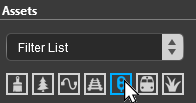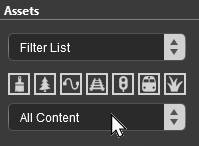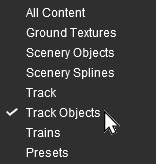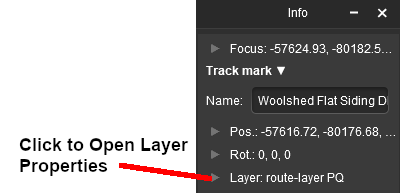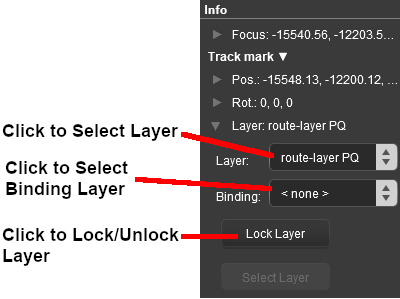|
|
| Line 340: |
Line 340: |
| | # select the '''Track Marker''' in the '''Tools Palette''' (or press the <span style="font-weight: 700; font-size: 17px; color: white; background-color: black;"> R </span> key) | | # select the '''Track Marker''' in the '''Tools Palette''' (or press the <span style="font-weight: 700; font-size: 17px; color: white; background-color: black;"> R </span> key) |
| | # '''Left''' click on the existing '''Track Marker''' in the route | | # '''Left''' click on the existing '''Track Marker''' in the route |
| − | # then '''left''' click on the '''Track Marker''' name in the Filter List | + | # then '''Left''' click on the '''Track Marker''' name in the Filter List |
| | This will instantly select the '''Track Marker''' in the Filter List and switch control to the '''Placement Tool'''.<br> | | This will instantly select the '''Track Marker''' in the Filter List and switch control to the '''Placement Tool'''.<br> |
| | | | |
Revision as of 10:06, 13 January 2023
The information in this Wiki Page applies to TANE, TRS19, Trainz Plus and TRS22.
|
|
| In Summary: |
 |
Track Marks are red coloured track objects that are invisible in Driver Mode but visible in Surveyor Mode |
 |
Track Marks are used as destinations or waypoints for AI driver commands |
 |
Track Marks only work on AI controlled trains. They have no effect on manually controlled trains |
 |
The direction that the marker is pointing has absolutely NO EFFECT on its operation |
|
What are Track Marks?
The Trainz AI relies heavily on Track Marks to direct trains around a layout. They are only visible in Surveyor Mode.
| Track Marks are the targets for:- |
 |
Drive To Trackmark and Navigate To Trackmark driver commands |
 |
Drive Via Trackmark and Navigate Via Trackmark driver commands |
| They can also be used as:- |
 |
attachments for Navigation Points |
 |
locations for Coupling operations |
Route or Session?
 |
Track Marks can be placed in a Route layer or in a Session layer |
 |
Notes:
 |
Placing Track Marks in a Route layer (e.g. in the same layer as the track) means that they will be available in all Sessions created using that particular Route.
|
 |
Placing Track Marks in a Session layer means that they will only be available in that Session. This can be useful if two or more Sessions are being created and you want to use different Track Marks (destinations and waypoints) in each Session.
|
|
|
 |
Information on Route and Session layers can be found at:-
|
Adding a Track Mark
 |
Notes:
A Track Mark has two important properties:-
- its name which is needed for all commands and rules that use the Track Mark, and
- its Trigger Radius (the red "wings" shown in the image below, the radius value is shown below the Track Mark name). This controls how closely an AI train has to approach the marker to activate it (smaller radius = closer to the Track Mark)
|
 |
The direction that a Track Mark is pointing has NO EFFECT on its operation |
|
In Surveyor Classic (S10)
Setting the Track Mark
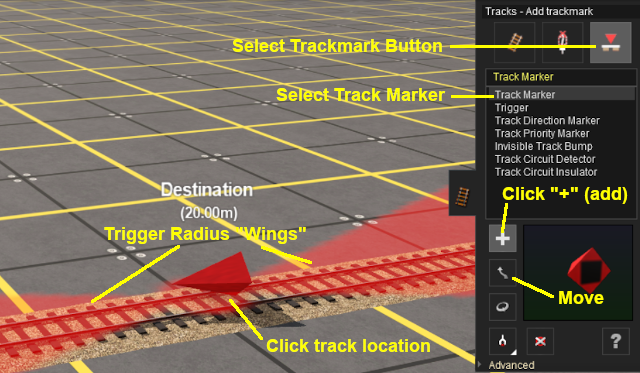 |
|
 |
Steps:
- Open the Track Tool
- Select the Trackmark button
- Select the item named Track Marker
- Select the + (add) button - it may already be selected
- Left click on the track location where the Track Mark is to be placed
If necessary, you can adjust the position of the Track Mark by dragging it along the track using the Move tool
|
|
When placed, the properties window for the Track Mark will appear.

Enter a name for the Track Mark and, if needed, select a layer. |
 |
Enter a useful name for each Track Mark - the name will be needed for driver commands. Most creators base the name on the location (e.g. "Maintown Track 1 North")
|
|
Set the Trigger Radius
At the bottom of the Track Tools flyout menu is an Advanced button. Left click this button to open the Track Mark advanced tool set.
 |
Once you have a Trigger Radius entered in the value box, you can apply it to any number of Track Marks by using method  shown above shown above
|
|
In Surveyor 2.0 (S20)
Surveyor 2.0 is currently only available for Trainz Plus Standard and Trainz Plus Gold subscription members.
Adding a Track Mark
 In the Asset Palette either:-
In the Asset Palette either:-
 Shortcut Shortcut
If you already have a Track Marker placed in your route then:-
- select the Track Marker in the Tools Palette (or press the R key)
- Left click on the existing Track Marker in the route
- then Left click on the Track Marker name in the Filter List
This will instantly select the Track Marker in the Filter List and switch control to the Placement Tool.
Jump to Step  below. below. |
|
 To narrow down the filter list, type "mark" (UPPER/lower case does not matter) in the Search Text Box
To narrow down the filter list, type "mark" (UPPER/lower case does not matter) in the Search Text Box
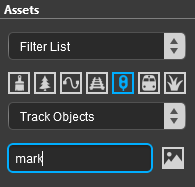 |
 This will list all the Track Objects containing the text "mark" in the filter list. This will list all the Track Objects containing the text "mark" in the filter list.
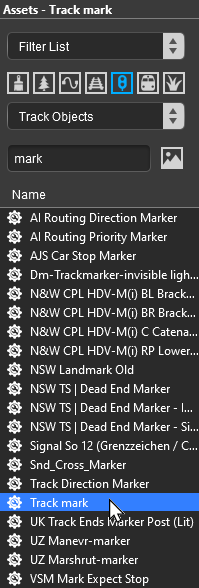 |
 Select the item Track Mark. Select the item Track Mark.
If you are not sure about an asset then double-click on the name to bring up its image and description. |
|
 Place the Track Mark on the track.
Place the Track Mark on the track.
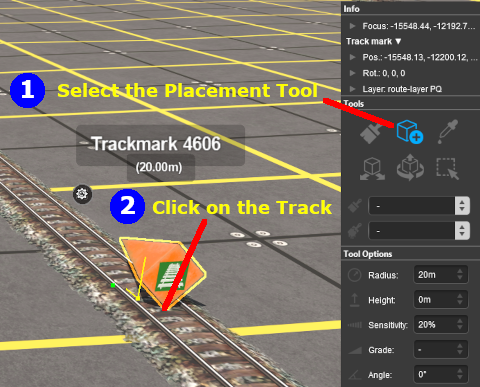
 |
Notes:
To delete a Track Mark (or any asset):-
- select either the:-
- Free Move Tool (or press S ) or
- Fine Adjustment Tool (or press D )
- Left click on the Track Mark
- press the Delete key
|
|
 |
If you need to rotate the Track Mark to face the opposite direction then:-
- Left click on its Context Tool (or press the T key if the asset has already been selected)
- from the popup menu select Rotate Trackside
Note: the direction it faces has no effect on its operation. |
|
|
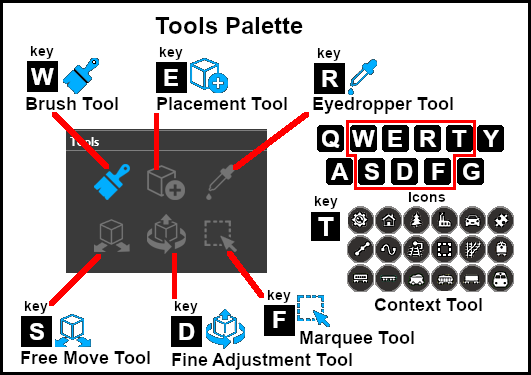
|
Set the Track Mark Properties
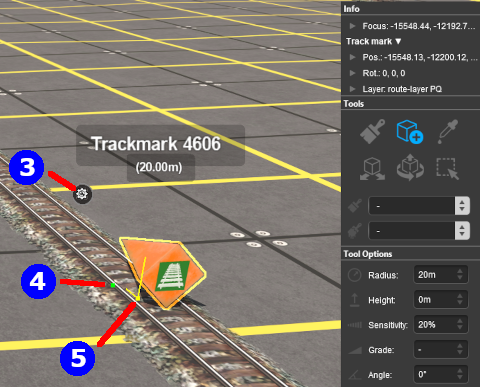 |
 Change Its Name Change Its Name
|
 |
Steps:
- Left click on the Context Tool (
 in the image on the left or press the T key if the asset has already been selected) to open up the object property and control menu in the image on the left or press the T key if the asset has already been selected) to open up the object property and control menu
- Left click on the Edit Properties option in the popup menu
- enter a name for the Track Mark
- click the
 to accept the change or the to accept the change or the  to reject it to reject it
|
|
|
 Set its Trigger Radius
Set its Trigger Radius
The Trigger Radius controls how closely an AI train has to approach the marker to activate it (smaller radius = closer to the Track Mark).
|
 |
Steps:
- Left click and hold down the mouse button on the Green Dot next to the Track Mark (
 in the images above and below) in the images above and below)
- While holding down the Left mouse button, move the mouse Forward or Backward to increase or reduce the trigger radius
|
|
Move the Track Mark
 Move it Along the Track
Move it Along the Track
|
 |
Steps:
- Left click and hold down the mouse button on the Yellow Dot next to the Track Mark (
 in the images above and below) in the images above and below)
- While holding down the Left mouse button, move the mouse Forward or Backward to drag the Track Mark along the track
|
|
 Reposition the it Left/Right
Reposition the it Left/Right
This feature allows a Track Mark to be physically placed left or right alongside the track so that it will not be hidden if a consist is parked on the Track Mark.
|
 |
Steps:
- Select the Fine Adjustment Tool (or press the D key)
- Left click and hold down the mouse button on the Red Horizontal Axis Line on the Track Mark (
 in the image above) in the image above)
- While holding down the Left mouse button, move the mouse Forward or Backward to move the Track Mark Left or Right of the track
|
|
|
|
 |
If you need to return the Track Mark to its original position then:-
- Left click on its Context Tool (or press the T key if the asset has already been selected)
- from the popup menu select Reattach to Track
|
|
Assign a Track Mark to a New Layer
Track Mark Operation
The most common use for Track Marks is as destinations for driver commands or as "way points" to direct a train to a destination via one or more intermediate places. They can also be used as the targets for Navigation Points and coupling operations.
Driver Navigation Commands
 |
Information on adding driver commands can be found at:-
|
 |
Drive To Trackmark and Drive Via Trackmark commands will NOT force the AI to find a clear path to the Track Mark if the shortest path is blocked |
 |
Navigate To Trackmark and Navigate Via Trackmark commands will force the AI to find a clear path to the Track Mark if the shortest path is blocked. The path chosen may not be prototypical |
 |
Drive To Trackmark
Instructs the AI driver to Drive, via the shortest available path, to the designated Track Mark. The AI will noticeably slow the train as it approaches the Track Mark. Switches ahead of the train that are not locked against the AI will be set to allow the train to proceed and reset after the train has cleared the switch. The AI driver will NOT attempt to find a way around blockages when calculating the shortest path to the Track Mark. All signals and speed signs along the route are obeyed.
This command is built in to Trainz
|
 |
Drive Via Trackmark
Instructs the AI driver to Drive, via the shortest available path, to and through the designated Track Mark. If there are no further navigation commands (e.g. Drive To, etc) then the AI will halt the train after passing the Track Mark. If there are further navigation commands then the AI will proceed through the Track Mark to the next Track Mark or Industry at normal speed. Switches ahead of the train that are not locked against the AI will be set to allow the train to proceed and reset after the train has cleared the switch. The AI driver will NOT attempt to find a way around blockages when calculating the shortest path to the Track Mark. All signals and speed signs along the route are obeyed.
This command is built in to Trainz
|
 |
Navigate To Trackmark
Instructs the AI driver to Drive, via the shortest available path, to the designated Track Mark. The AI will noticeably slow the train as it approaches the Track Mark. Switches ahead of the train that are not locked against the AI will be set to allow the train to proceed and reset after the train has cleared the switch. The AI driver will attempt to find a way around blockages when calculating the shortest path to the Track Mark. All signals and speed signs along the route are obeyed.
This command is built in to Trainz
|
 |
Navigate Via Trackmark
Instructs the AI driver to Drive, via the shortest available path, to and through the designated Track Mark. If there are no further navigation commands (e.g. Navigate To, etc) then the AI will halt the train after passing the Track Mark. If there are further navigation commands then the AI will proceed through the Track Mark to the next Track Mark or Industry at normal speed. Switches ahead of the train that are not locked against the AI will be set to allow the train to proceed and reset after the train has cleared the switch. The AI driver will attempt to find a way around blockages when calculating the shortest path to the Track Mark. All signals and speed signs along the route are obeyed.
This command is built in to Trainz
|
Navigation Points
Navigation Points can be attached to Track Marks to provide users with session instructions.
 |
Information on navigation points can be found at:-
|
Coupling Operations
An AI controlled train can be issued with a driver command to couple with the consist located at a specified Track Mark.
 |
The AI driver moves the train (or just the locomotive if it is by itself) to couple with the wagon that is closest to a specified trackmark. More information on this command can be found at  Couple At Trackmark Couple At Trackmark
This command must be downloaded from the DLS and installed in Trainz
|
 |
Information on adding driver commands can be found at:-
|
Related Links
Trainz Wiki
 |
More Tutorials and Guides to Using Trainz
|
This page was created by Trainz user pware in September 2019 and was last updated as shown below.


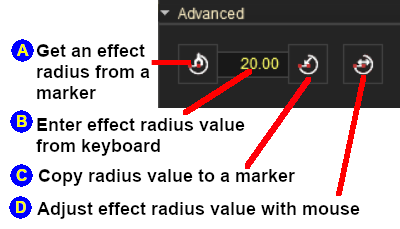
In the Asset Palette either:-
To narrow down the filter list, type "mark" (UPPER/lower case does not matter) in the Search Text Box

Place the Track Mark on the track.


![]() Set its Trigger Radius
Set its Trigger Radius
![]() Move it Along the Track
Move it Along the Track
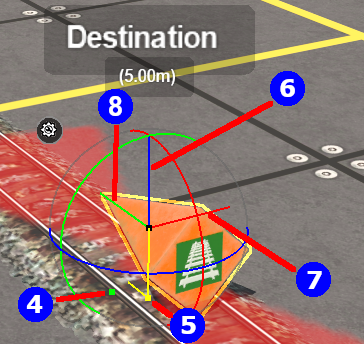
![]() Reposition the it Left/Right
Reposition the it Left/Right







